

MAEKAWA Senpan (前川千帆)
|
 Maekawa Senpan (前川千帆 1888-1960), whose original name was Ishida Shigezaburô (石田重三郎), was born in Kyoto. He was the son of a shopkeeper and the younger brother of a minor print artist, Asaga Manjirô (1885-1965). He studied at the Kansai Bijutsu-in (Kansai Fine Art Academy) starting in 1905, at first with Asai Chû (1856-1907), then with Kanokogi Takeshirô. After moving to Tokyo in 1911, he began a long career as a cartoonist for the monthly magazine "Tokyo Puck" (Tokyo pakku, 東京パック 1905-1912).
Maekawa Senpan (前川千帆 1888-1960), whose original name was Ishida Shigezaburô (石田重三郎), was born in Kyoto. He was the son of a shopkeeper and the younger brother of a minor print artist, Asaga Manjirô (1885-1965). He studied at the Kansai Bijutsu-in (Kansai Fine Art Academy) starting in 1905, at first with Asai Chû (1856-1907), then with Kanokogi Takeshirô. After moving to Tokyo in 1911, he began a long career as a cartoonist for the monthly magazine "Tokyo Puck" (Tokyo pakku, 東京パック 1905-1912).
Upon returning from a sojourn in Korea 1915-17, he resumed his cartoon work, this time for the newspaper Yomiuri shinbun (読売新聞 founded in 1874). In that paper he made a reputation as the creator of a cartoon series featuring a clumsy bear named Awatemono no Kumasan ("Hasty Bear"). Maekawa's other cartoons also appeared in one of the most successful pre-World War II manga publications, the Yomiuri Sandê Manga (Yomiuri Sunday Cartoon: 讀賣サンデー漫画).
In Maekawa's single-sheet woodcuts, there is an assimilated persistence of the drawing style derived from his book illustration and cartooning. His figures from everyday life often appear adapted from long-standing Kyoto-Osaka genres, including Maruyama (円山) and Shijô (四条) art, and are perhaps reminiscent in intention even if in a modern idiom, of many lively, free-wheeling sketches and caricatures by a long list of artists from both Kyoto and Edo, such as Ki Baitei (紀楳亭 1744-1810), Matsuya Nichôsai (松屋耳鳥齋 c. 1751-c. 1803), Yamaguchi Soken (山口素絢 1759-1818), Aoi Shûho (葵秋圃 1768-1859), Nishimura Nantei (西村楠亭 1775–1834), Satô Suiseki (佐藤水石 act. c. 1806-1840), and Ônishi Chinnen (大西椿年 1792-1851). There is a purposeful and charming artlessness in Maekawa's figure drawing — simplicity, stylized naturalism, and cheerfulness often characterize his work.
Statler reported on one of the block-cutting methods used by Maekawa, who started with a "fairly free drawing, which he doesn't allow to restrict him as he carves. He pastes the drawing on the wood and cuts the block for thr basic color. He makes an impression of this block and pastes it on wood as a guide in cutting the block for another color. In this way he is sure that his blocks will match up."
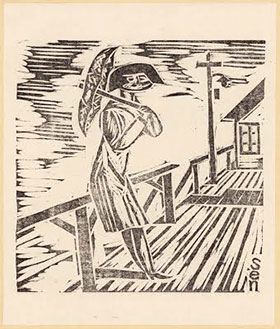 Maekawa began printmaking after viewing an exhibition of prints by Minami Kunzô (南薫造 1883-1950) in 1911, whereupon he was inspired to take up self-carved woodblock printing (sôsaku hanga), which he taught himself over a ten-year period. He told Oliver Statler that, "Later, I got acquainted with some artisans and found they could have taught me the same things in a few hours." Maekawa exhibited for the first time with the Nihon Sôsaku Hanga Kyôkai (Japan Creative Print Association: 日本創作版画協会 founded 1918) starting in 1919, and he was a founding member and frequent exhibitor with the Nihon Hanga Kyôkai (Japanese Print Association: 日本版画協会) from 1931, the year it was founded, until his death in 1960. Finally, by around 1953, Maekawa became successful enough to earn his living primarily from woodcut printmaking and book illustration, although as it was for much of sôsaku hanga in the early years, many specific prints did not often sell well and he made few copies of most of his works (some were printed by others at later dates).
Maekawa began printmaking after viewing an exhibition of prints by Minami Kunzô (南薫造 1883-1950) in 1911, whereupon he was inspired to take up self-carved woodblock printing (sôsaku hanga), which he taught himself over a ten-year period. He told Oliver Statler that, "Later, I got acquainted with some artisans and found they could have taught me the same things in a few hours." Maekawa exhibited for the first time with the Nihon Sôsaku Hanga Kyôkai (Japan Creative Print Association: 日本創作版画協会 founded 1918) starting in 1919, and he was a founding member and frequent exhibitor with the Nihon Hanga Kyôkai (Japanese Print Association: 日本版画協会) from 1931, the year it was founded, until his death in 1960. Finally, by around 1953, Maekawa became successful enough to earn his living primarily from woodcut printmaking and book illustration, although as it was for much of sôsaku hanga in the early years, many specific prints did not often sell well and he made few copies of most of his works (some were printed by others at later dates).
Maekawa was focused almost exclusively on woodcuts. He said that "Etching? Wood engraving? Painting? They're simply not agreable to me. To me, the wood-print quality is everything. Even calligraphy made with a brush is never wholly satisfying. I like a character only when it has been cut in wood." However, Maekawa did briefly explore linocuts, as in his small-format series Yagai shôin (Outdoor sketches: 野外小品) comprising five sets of ten prints each made during the years 1928-1935. Some of the prints were also published in 1932 in the magazine Han geijutsu (Print art: 版芸術). In the example on the left from 1928, a fashionable moga (moden garu, modern girl: モダンガル) wearing a Western-style dress with her hair in a flapper-style bob holds a parasol over her shoulder while leaning against a railing. The "naive" rendering of the girl is typical of Maekawa's cartoon and folk-art manner of figurative drawing in the 1920s and 1930s.
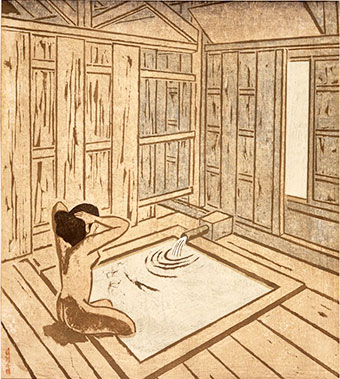 Maekawa is considered was one of the great personalities of twentieth-century Japanese printmaking, known for his independence and radical political beliefs. Yet he was also a dedicated traditionalist and supporter of Japanese folk life and customs. He is most admired for his depictions of Japanese manners and customs in large numbers of single-sheet prints and albums. Maekawa collaborated on some group series, such as Shin Tokyo hyakkei (One hundred views of new Tokyo: 新東京百景), 1929-32, for which he contributed 12 prints, and Shin Nihon hyakkei (One hundred views of new Japan: 新日本百景) 1938-41, contributing two prints and also serving as editor for print nos. 10 through 39, after which publication ceased due to the Second World War.
Maekawa is considered was one of the great personalities of twentieth-century Japanese printmaking, known for his independence and radical political beliefs. Yet he was also a dedicated traditionalist and supporter of Japanese folk life and customs. He is most admired for his depictions of Japanese manners and customs in large numbers of single-sheet prints and albums. Maekawa collaborated on some group series, such as Shin Tokyo hyakkei (One hundred views of new Tokyo: 新東京百景), 1929-32, for which he contributed 12 prints, and Shin Nihon hyakkei (One hundred views of new Japan: 新日本百景) 1938-41, contributing two prints and also serving as editor for print nos. 10 through 39, after which publication ceased due to the Second World War.
After the War, he contributed to the portfolios Tokyo kaiko zue (Recollections of Tokyo: 東京回顧図絵), 1945; Nihon mizoku zufu (Picture notes on native customs of Japan: 日本民族図譜), 1946; and Nihon jozoku sen (Selection of customs of Japanese women: 日本女俗選), 1946, all published by Fugaku Shuppansha (富岳出版舎). Maekawa's solo (small format) collections included the portfolio of five prints titled Nihon fûkei hanga karuizawa no zu (Prints of Japanese landscapes, views of Karuizawa: 日本風景版画軽井沢之図部), 1929 (198 x 166 mm); the five albums of Yokusen fu (Hot Springs: 版画浴泉譜), 1941-59 (212 x 213 mm); and the 27-volume series of woodblock-printed books called Kanchû kanbon (Leisure-time leisure books: 関中関本), 1945-60 (165 x 182 mm).
The large-format (503 x 432 mm) woodcut from 1949 shown immediately above right depicts a young woman in a hotspring bathhouse in Beppu (別府), Kyûshû (九州), where there are eight major geothermal hot spots, sometimes referred to as the Beppu no jigoku (Eight Hells of Beppu: 別府の地獄). The print was first produced in a very small edition, reported to be only five copies, after which Maekawa retained the keyblok but destroyed the color blocks. The design was later republished by Kato using the original keyblock and newly carved color blocks. One of the less complicated works to produce, there were four printing stages using the keyblock (katsura 桂 Japanese Judas tree) and three plywood blocks faced with shina (科 basswood or Japanese linden). The pigments were all poster colors and the paper torinoko (鳥の子).
The image at the top of this page portrays a flower vendor in Kyoto. Made in 1951, it measures 388 x 305 mm. Maekawa used six blocks of plywood faced with shina and a combination of Japanese pigments and poster colors on torinoko paper. The design required 10 printing stages. Maekawa remembered these young female flower vendors from his childhood, but there were far fewer by the time he made the print. Colorful, charming, and playful, the design typifies Maekawa's approach toward much of his "portraiture" in which he captures the manner and appearance of a feminine type without actually using a real-life model.
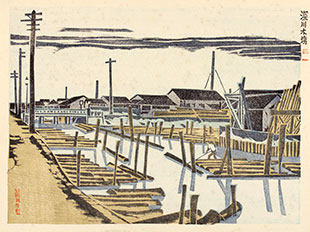 |
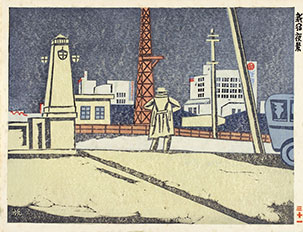 |
| Maekawa Senpan: Fukugawa kiba, 1930 (ed. 50) (Fukugawa lumber yard: 深川木場), 197 x 267 mm |
Maekawa Senpan: Shinjuku yakkei 1931 (Night view at Shinjuku: 新宿夜景), 200 x 279 mm |
Maekawa also produced cityscapes and landscapes. Two early relatively examples are shown above. On the left is a view of the Fukugawa lumber yard, a site that dates back to the aftermath of the Edo-Meireki fire of 1657 when the shogunate authorized establishing lumber production on swamp-land east of the Sumida River, mainly in Fukagawa, where they also constructed a maze of canals, bridges, and landings. The area remained a lumberyard until the early 1970s, when it was relocated to Shin-kiba (New Lumberyard: 新木場). The old yard was then turned into Kiba Kôen (Kiba Park: 木場公園). The Fukugawa yard had a long history in woodblock prints. Utagawa Hiroshige (1797-1858), for example, designed a print for his Meisho Edo hyakkei (One hundred famous views of Edo: 名所江戸百景) in 1856. A number of sôsaku hanga artists portrayed these lumber yards as well, including Un'ichi Hiratsuka (1895-1997), Kishio Koizumi 1893-1945), and Masao Maeda (1904-1974). Maekawa's print was made in 1930 as part of the aforementioned collaborative series Shin Tokyo hyakkei. For a site that would often bristle with activity, the view is surprisingly serene.
Immediately above right is a July 1931 print titled Shinijuku yakei (Night view at Shinjuku: 新宿夜景). This design was recut, renamed Shinjuku no yo (Shinjuku at night: 新宿の夜), and printed in December 1945 for the series Tokyo kaiko zue (Retrospective scenes of Tokyo: 東京回顧圖會), a portfolio of 15 prints created by nine artists who were all members of Nippon Hanga Kyôkai (Japan Print Association). The later set was published by Uemura Masurô (上村益郎) of Fugaku Shuppansha (富岳出版舎) and printed by the studio of Takamizawa Mokuhan Honsha Kôbô (高見澤木版本社工房). For the Shinjuku design, one notable change was the replacement of the dark blue sky with a perhaps intentionally bleaker very dark gray.
 |
| Maaekawa Senpan: Inn at Kamisuwa, room overlooking the lake (湖の見える室 信濃諏訪湖畔), 1932-33 |
On occasion, Maekawa relied less on folk-art mannerisms and more on the sôsaku hanga realist aesthetic. In a 1932 self-printed woodcut he depicted young woman seated at a low table in a room at an inn in Kamisuwa overlooking Lake Suwa (Room with lake view, Lake Suwa: 湖の見える室 諏訪湖畔), which is in the central mountain area of Japan's main island, Honshu. In this instance, Maekawa's drawing style is more in line with other artists of the 1920s and 1930s. In fact, the woodcut was shown in an exhibition, the Feb-April 1934 L'estampe japonaise moderne et ses origines at the Musée des arts decoratifs in Paris, organized by the artist Hasegawa Kiyoshi (1891-1980). The exhibition apparently prompted Maekawa to prepare or submit a more conventional work in composition and technique. Statler (ref. below) says that Maekawa's primary tool was a curved chisel with an angled blade. The print is large (440 x 533 mm) and very rare, having been made in an edition of only six or seven impressions, after which the blocks were destroyed. There were eight printing stages using eight blocks of solid katsura, with poster colors and Japanese pigments on torinoko paper. 湖の見える室 (信濃諏訪湖畔
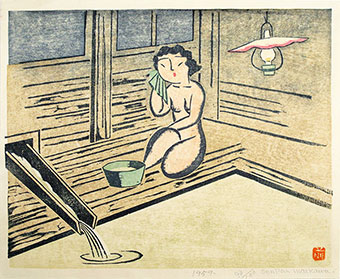 Maekawa's woodcut for the collaborative portfolio Gendai meika sôsaku hanga shû (Collection of famous contemporary creative prints: 現代名家創作版画集) of 1959, published only a year before his death, was titled "Bathing at a hot spring." Maekawa was one of 10 artists who participated, each designing one print for an edition of 100. Maekawa's appealing folk-art style is on full display. He used a confident line, modulated in thickness and edge smoothness to create the naturalistic forms. His expert printing of textures conveys an atmosphere of normality and everyday ordinariness. The simplified forms, reduced to essentials, make the composition easily accessible. Yet while what we see in the present print might at first glance appear to be naive or artless, it is in fact a rather warm and appealing interpretation of a young woman enjoying herself in the bath, one of Maekawa's favorite themes—he was known to scout out hot springs (onsen: 温泉) for suitable subjects to draw and cut into woodblocks. James Michener once wrote a description of another print by Maekawa Senpan that would have been appropriate for the present design: "The subdued color scheme is his. The touch of pink has been called almost a Maekawa trademark. And the winsome little girl is a sister to the hundreds of others he depicted. He was an artist with a feminine approach to life, indifferent to the tides of modernism that have swept his colleagues, and content to look lovingly at the village aspects of a land and a society that he obviously loved."
Maekawa's woodcut for the collaborative portfolio Gendai meika sôsaku hanga shû (Collection of famous contemporary creative prints: 現代名家創作版画集) of 1959, published only a year before his death, was titled "Bathing at a hot spring." Maekawa was one of 10 artists who participated, each designing one print for an edition of 100. Maekawa's appealing folk-art style is on full display. He used a confident line, modulated in thickness and edge smoothness to create the naturalistic forms. His expert printing of textures conveys an atmosphere of normality and everyday ordinariness. The simplified forms, reduced to essentials, make the composition easily accessible. Yet while what we see in the present print might at first glance appear to be naive or artless, it is in fact a rather warm and appealing interpretation of a young woman enjoying herself in the bath, one of Maekawa's favorite themes—he was known to scout out hot springs (onsen: 温泉) for suitable subjects to draw and cut into woodblocks. James Michener once wrote a description of another print by Maekawa Senpan that would have been appropriate for the present design: "The subdued color scheme is his. The touch of pink has been called almost a Maekawa trademark. And the winsome little girl is a sister to the hundreds of others he depicted. He was an artist with a feminine approach to life, indifferent to the tides of modernism that have swept his colleagues, and content to look lovingly at the village aspects of a land and a society that he obviously loved."
Works by Maekawa Senpan are in many institutional collections, including the Art Gallery of Greater Victoria; Art Gallery of New South Wales; Art Institute of Chicago; British Museum, London; Brooklyn Museum, New York; Carnegie Museum of Art, Pittsburgh; Fine Arts Museums of San Francisco; Fukushima Prefectural Museum of Art; Harvard Art Museums, Cambridge, MA; Honolulu Museum of Art; Los Angeles County Museum of Art; Minneapolis Institute of Art; Museum of Fine Arts, Boston; National Museum of Asian Art (Smithsonian), Washington, DC; National Museum of Modern Art, Tokyo; Philadelphia Museum of Art; Portland Art Museum, OR; and Rijksmuseum, Amsterdam. © 2020 by John Fiorillo
BIBLIOGRAPHY
- James Michener, The Modern Japanese Print: An Appreciation. Rutland: Tuttle, 1962, p. 19 (original folio edition) or 1968, p. 21 (popular edition).
- Riccar Art Museum: Maekawa Senpan meisaku-ten (Exhibition of masterworks by Maekawa Senpan: 前川千帆名作展). Tokyo: 1977.
- Oliver Statler, Modern Japanese Prints: An Art Reborn. Rutland: Tuttle, 1956, pp. 45-52, 190-191, nos. 22-28.
- Uhlenback, C., Newland, A.R., de Vries, M.: Waves of renewal: modern Japanese prints, 19900 to 1960. Leiden: Hotei Publishing, pp. 73-77 and 191-197.
Viewing Japanese Prints |